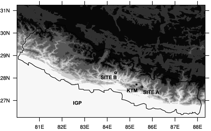Aerosol-Cloud-Rainfall Interactions in the Central Himalayas
Project Description:
The overarching research objective of this research is to investigate aerosol-cloud-rainfall interactions in the Central Himalayas with a focus on elucidating the impact of anthropogenic aerosols on cloudiness, the space-time variability of precipitation, and ultimately the regional water cycle in the northern Indian subcontinent, and in particular the Ganges river basin.
To assess this indirect effect of aerosols, we rely on the following methodology:
- Analysis of remote sensing aerosol, cloud and rainfall products from MODIS, TOMS and TRMM.
- Field Campaigns for characterizing the aerosol physical and chemical properties including the thermodynamic variables and wind profiles in the region. Instrumentation for aerosol measurements like Scanning Mobility Particle Sizer (SMPS) and IC/TOC for analysis of filter data are available (through collaboration with Prof. Andrei Khlystov Research Laboratory, http://aerosol.pratt.duke.edu/) at Duke University). A wide array of instrumentation for the measurement of meteorological variables is available in our lab.
- Numerical study using cloud resolving models with double moment microphysics, coupled with a land surface model
Himalayas
The Himalayas act as a barrier that separates a region of abundant aerosols in the Indo-Gangetic Plains (IGP) from the region of pristine air at high altitude in the Tibetan plateau. Statistical analysis of remote sensing data from multiple satellite platforms over the Himalayas shows a strong seasonal cycle of aerosol build up and decay with aerosol peaks during the pre-monsoon/winter season and scavenging of aerosols during the monsoon.
On a more local scale, the mountainous terrain of the Himalayan system is dissected by numerous river valleys. As the dissected nature of terrain is important in decoupling the winds in the valley from the synoptic scale winds above, these river valleys act as narrow pockets for the accumulation of aerosols within the ridges. Recent field experiment campaigns in Central Nepal provide new insights and confirm previous work regarding the role of mountain-valley circulations in the diurnal cycle of aerosol number and mass concentration across the Middle Himalaya range and document evidence of the role of synoptic scale transport and weather controls (haze events and rainfall) in modulating the amplitude of the diurnal cycle and day-to-day variability of aerosols in the pre-monsoon season. The study also characterizes the aerosol size distribution and chemical composition of aerosols during May~June 2009.
The numerical model we are using is a modified version of the 3-D non-hydrostatic, anelastic model which has been documented in detail by Clark (1977, 1979), Clark and Farley (1984), Clark and Hall (1991,1996). The model has been successfully used for simulating flows over complex terrains [Hoinka and Clark (1991), Clark and Miller (1991), Bhushan and Barros (2007) among many others].
This new cloud microphysical scheme was previously introduced into the model by Richard Farley. The warm rain aspects of the scheme are based on Cohard and Pinty (2000), whereas much of the ice treatment is patterned after Ferrier (1994).It assumes two classes of liquid particles, cloud water and rain, and four classes of ice particles, cloud ice crystals, snow, graupel, and hail.
Publications
- Shrestha P., A.P. Barros, 2010: Joint spatial variability of aerosol, clouds and rainfall in the Himalayas from satellite data, Atmos. Chem. Phys., 10, 8305-8317, doi:10.5194/acp-10-8305-2010
- Shrestha P., Barros A.P.,, Khlystov A., Chemical composition and aerosol size distribution of the middle mountain range in the Nepal Himalayas during the 2009 pre-monsoon season, Atmospheric Chemistry and Physics - Discussions, vol. 10 (2010), ppt. 15629-15670

